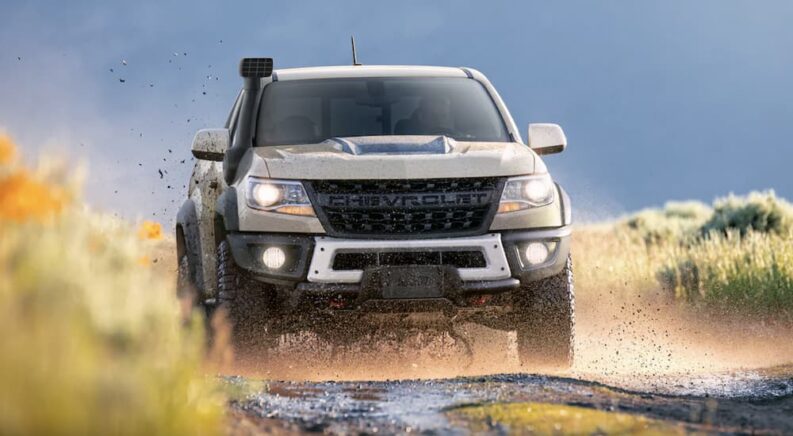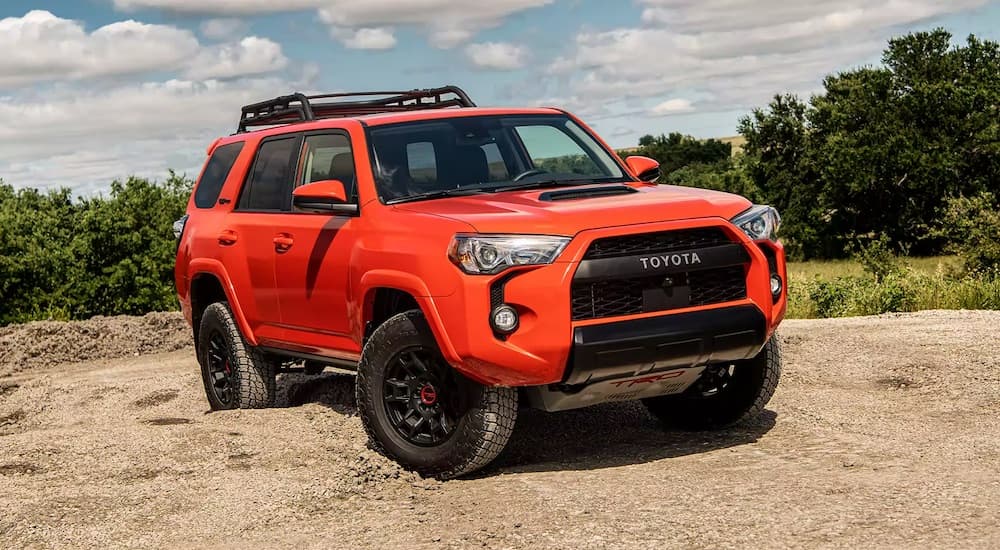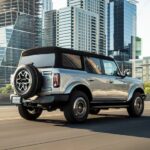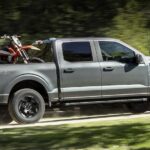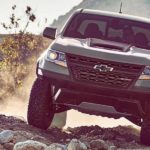For many drivers, choosing a used car for sale simply comes down to getting from point A to point B as efficiently and comfortably as possible. This leads many to prioritize fuel economy, convenience features, modern safety, and infotainment technology. That equation starts to change when you look at the journey, not the destination, as the ultimate goal. Off-roading adds a visceral element to the driving experience. Between exploring new locales, dodging obstacles, and testing a vehicle’s absolute limits, off-road driving provides an engaging experience as much of a sport as any activity involving a helmet, pads, or pigskin.
There’s only one issue with embracing the off-road lifestyle. Some of today’s most well-equipped off-road models tend to come at a premium, with prices routinely topping $50,000, but that’s where used cars for sale come in. Investing in a used off-road truck or SUV is a great way to experience the road less traveled without breaking the bank, which is why we’ve compiled a short list of some of the best off-road-ready models on the pre-owned market. We’ll also review those features that can make a difference when tackling off-road terrain, hopefully allowing readers to approach their next purchase with more confidence.
Does It Have What It Takes?
Before we dive into some of our favorite models, we thought it might be helpful to review some of the features that separate true off-road vehicles from your average pickup or SUV. Just because a truck or SUV bills itself as an off-road model doesn’t necessarily mean that it has the equipment it needs to withstand life on the road less traveled, which is why drivers need to familiarize themselves with the specific components that really translate to off-road ability.
Four-Wheel Drive
A potent engine is always a good start, but there’s no underestimating the importance of a hardy drivetrain when you’re weighing different off-road options. A good four-wheel drive system is a must, distributing power to every corner of the vehicle to improve stability, control, and traction when encountering loose surfaces or steep inclines. But that’s just one part of the equation. Any off-road vehicle worth its winch should include two other components that significantly increase the chances of success in low-traction environments.
Low-Range Transfer Case
A low-range transfer case essentially allows vehicles to swap between their everyday gears and an additional set that is designed with low-speed, high-traction driving in mind. When activated, a low-range transfer case gives a vehicle a significantly reduced gear ratio that’s perfect for steadily climbing a steep hill, picking your way between boulders, or escaping from a muddy stretch of trail. Remember, it’s torque, not raw horsepower, that’s really the star of the show when it comes to off-road driving, and a low-speed transfer case offers torque in spades.
Locking Differential
A locking differential is another must-have component for any off-roader. These differentials come in all different variations, and can be found on the front and/or rear axle, but they all serve the same basic purpose: locking the wheels together to increase traction by forcing both wheels to rotate at the same speed. It might sound a little technical, but a locking differential prevents the sort of wheelspin that can prove so frustrating in low-traction scenarios.
Off-Road Suspension
You’re bound to experience more than a few bumps in the road when you set off on an off-road adventure, which is why a good suspension is vital. In addition to improving a vehicle’s ground clearance to avoid rocks, logs, and other obstacles you might encounter, an off-road suspension also improves ride quality, traction, and handling. It can allow a driver to upgrade to a larger set of all-terrain tires by increasing the vehicle’s ride height. Whether you go for a long-travel suspension or an advanced suspension system with high-performance shocks, coilovers, and adjustable control arms, you’ll quickly learn just how helpful a little extra ground clearance and cushioning can be.
Tires
The stock tires that come on most of today’s vehicles are designed to maximize on-road efficiency and comfort, but they’re no substitute for a set of good, knobby off-road tires. Equipped with a more aggressive tread pattern that improves traction while effectively ejecting mud, rocks, and anything else that might get lodged in between the grooves, off-road tires can greatly impact the driving experience. Larger off-road tires also increase a vehicle’s ground clearance, create a larger contact patch with the road, and, when paired with a set of beadlock-capable wheels, can even be aired down to essentially float over loose surfaces like sand.
Chassis
Some vehicles have off-roading in their bones, which, in the anatomy of a truck or SUV, would equate to the chassis. This rigid framework underpins nearly every component you can imagine, and it’s not to be taken for granted. While the rise of car-like crossover trucks and SUVs has seen the traditional body-on-frame design steadily replaced with a unibody approach, those looking to explore some off-the-grid destination should opt for the old-fashioned approach. A body-on-frame vehicle is better able to resist the intense twisting and flexing forces that can come with heavy-duty off-road use, is easier to repair, and can also have a big impact on towing capacity.
Underbody Protection
When you embrace the world of off-road driving, the question isn’t if you’re going to earn a few bumps and bruises but when. Even the most observant driver is bound to miss a well-hidden rock or misjudge their ground clearance, but some good underbody protection serves as your first line of defense. Underbody skid plates basically serve as a form of automotive armor, protecting sensitive and expensive underbody components from the worst the trail has to offer. A good set of skid plates will typically cover the oil pans, transfer case, exhaust system, steering racks, and other components you wouldn’t want to lose when you’re miles away from the closest mechanic.
In addition to all the components and systems listed above, drivers should weigh a few other factors before sourcing their next off-road rig. A winch can prove to be an important piece of recovery gear when you find yourself wallowing in the mud, so keep an eye out for a model with a winch-capable bumper. A snorkel kit helps to keep the engine supplied with fresh air when you start fording streams, while rock sliders protect the sides of the vehicle the same way as skid plates do for the underbody. Finally, there’s the approach, departure, and breakover angles, which describe the geometry of the front and rear bumper as well as the underside of the vehicle. If you want to engage in some aggressive off-road driving, especially climbing and descending steep hills, you’ll want to pay attention to these three measurements as they play an important role in preventing bumps, dents, and underbody damage.
Jeep Wrangler Rubicon
We’ll start with the granddaddy of the modern off-road segment: the Jeep Wrangler. There’s no doubting Jeep’s credentials when it comes to off-road performance, with the American brand producing some of the industry’s first true go-anywhere vehicles for military use as far back as 1940. Originally introduced in 1986, the Wrangler represents the culmination of Jeep’s 80-plus years in the off-road market. The Wrangler’s current JL generation does the brand proud with a robust 4WD system, including part- or full-time settings, 10.8 inches of ground clearance, and a 44-degree approach angle that few other off-road models can match.
Every Wrangler boasts some level of off-road ability, but if you’re really trying to improve your chances on your next off-road excursion, the Rubicon trim is the obvious choice. Equipped with everything from front and rear locking differentials to a heavy-duty transfer case with a 4:1 gear ratio, a sturdy suspension with top-of-the-line shocks, and an electronic sway-bar disconnect feature, the Wrangler Rubicon doesn’t cut any corners in terms of off-road performance. Jeep also offers the Wrangler in hybrid form courtesy of the 4xe model, which provides a more efficient alternative to the regular version without sacrificing any off-road ability.
Chevy Colorado ZR2
Bigger isn’t always better when you’re talking about off-road performance. While the full-size Chevy Silverado is one of the most capable towing rigs on the planet, its generous dimensions don’t do it many favors when you’re trying to explore some narrow off-road environs. The midsize Chevy Colorado is much better suited to the task, especially when you’re behind the wheel of the ZR2 trim.
Debuting in 2017, the ZR2 improved the Colorado’s already impressive off-road resume with a host of exclusive components that let the midsize pickup run circles around some of the segment’s more basic offerings. The ZR2 not only rides higher than the average Colorado with 8.9 inches of ground clearance, but it also features a wider track that improves stability while reducing the chances of a ride-ending rollover. Full-time 4WD and electronic-locking differentials come standard, as do 35-inch tires, beadlock-capable wheels, rock rails, and a dedicated Off-Road mode that tailors the truck’s brakes, traction, and stability control for off-road use.
That’s a pretty comprehensive package, but the Colorado ZR2’s Multimatic Dynamic Suspensions Spool Valve (DSSV) suspension really ups the ante. These spool valve shocks offer more accurate and consistent damping versus traditional shocks and can be turned for both on- and off-road use. The Multimatic dampers are perfect for a long day on the trail, resisting the heat fade that can come with extended use and making for an all-around more comfortable driving experience.
Toyota 4Runner TRD Pro
Toyota just introduced the new sixth-generation 4Runner for the 2025 model year, which means the fifth-generation models are now a little easier to come by. While you might miss out on some of the newer features and Tacoma-based platform, the fifth-generation 4Runner is no slouch when it comes to off-road performance. The 4Runner is offered in a wide range of trims, including two models that feature “Off-Road” right in the name. Those hunting for the most adventure-ready version need look no further than the TRD Pro.
This range-topping trim pulls out all the stops to provide drivers with a true off-road machine that’s ready to kick up a little mud. An electronically controlled locking rear differential, skid plates, Nitto Terra Grappler all-terrain tires, and upgraded front and rear bumpers with improved approach and departure angles are just the tip of the iceberg. The TRD Pro’s FOX Racing high-performance shocks with TRD-tuned front springs and rear remote reservoirs really sweeten the deal. The 2.5-inch internal bypass shocks are soft at first but steadily stiffen when faced with rough terrain. That means comfort when you need it and protection when it’s most crucial. Traction is the name of the game when you’re trying to achieve off-road glory, and the 4Runner delivers with an advanced traction control system that includes a Multi-Terrain Select System and a Crawl Control feature that allows drivers to focus on picking their path through a tricky stretch of trail at low speeds while the SUV handles all the braking and acceleration duties.
Ford Bronco
The original Ford Bronco was an icon in its own right, but Ford’s first SUV is now back and better than ever, with the automaker reviving the badge in 2021. The basic Bronco offers a pretty solid package with a 43.2-degree approach angle and 11.6 inches of ground clearance. It also offers a G.O.A.T. (Go Over Any Terrain) system that features up to nine distinct driving modes, including specific settings for sand/snow, mud/ruts, rock crawling, and high-speed desert racing.
If you’re browsing the pre-owned market, the Wildtrak is the Bronco to look out for. This trim is built around an advanced 4X4 system with automatic on-demand engagement, locking rear differentials, and, most importantly, Ford’s High-Performance Off-Road Stability Suspension (HOSS 3.0) with FOX internal bypass dampers. The supersized suspension is all part of the Bronco’s Sasquatch package, which enhances the normal Bronco with a high-clearance suspension, position-sensitive Bilstein shock absorbers, and fender flares. It also includes a heavy-duty modular steel bumper, steel bash plates, and beadlock-capable wheels. Integrated auxiliary switches allow drivers to customize the SUV with an air compressor or winch, and the Bronco also boasts a 3,500-pound towing capacity thanks to its 2.7L twin-turbocharged V6 that puts out 330 hp and 415 lb-ft of torque. Ford has replaced the Wildtrak with the new-yet-nostalgic Stroppe Edition for 2025, which offers all the same features in a slightly more luxurious package complete with a distinct red, white, and blue paint job designed to honor off-road pioneer and Ford collaborator Bill Stroppe.
We’ve provided a list outlining some of our favorite used models for off-road adventures, but it’s far from exhaustive. While the Jeep Wrangler, Chevy Colorado, Toyota 4Runner, and Ford Bronco all represent enticing options, knowing what sort of off-road features to look for is a lot more helpful than gravitating toward specific makes and models. Automakers have been introducing new off-road trims at a record pace lately, but not every offering has the gear required to make the most of your next off-road journey. While upsized tires, skid plates, and sporty graphics might turn some heads, it’s important to steer clear of the so-called “soft-roaders” that look the part without offering an appropriate arsenal of off-road equipment. A good 4WD system and suspension should be your primary concern, though you also shouldn’t discount the importance of locking differentials and a low-range transfer case. If you want to experience the type of fun that can only come with leaving paved surfaces behind, make sure your next off-road truck or SUV ticks all these boxes.

